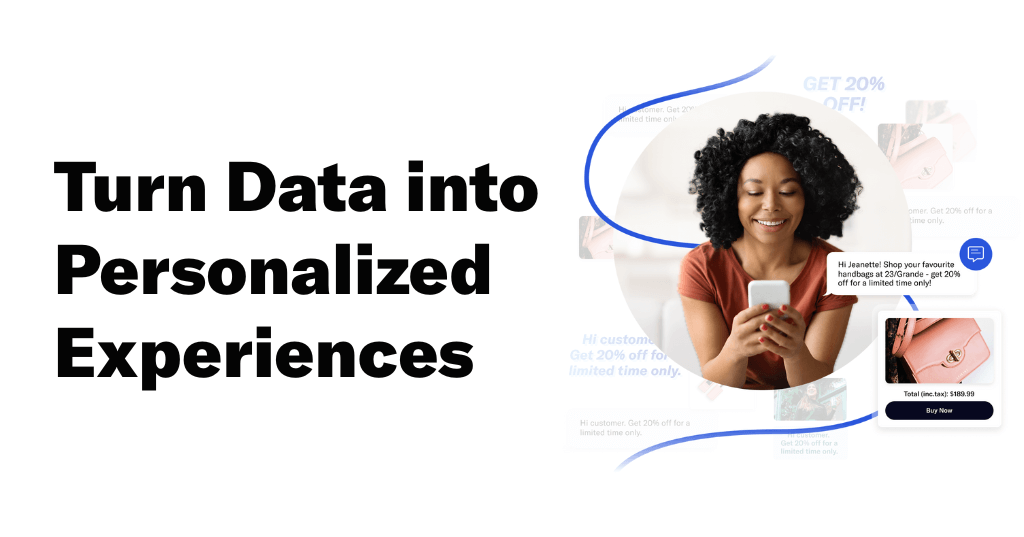What’s the Difference Between First-Party Data vs. Zero-Party Data?

Ali Haris VP, Product Marketing, Airship

Share to my network
In this article
Categories
Book a meeting
Connect with our team of experts to discuss your conversion and loyalty goals, and how we can help you achieve them faster.
Get a demoTL;DR: Brands are moving away from third-party to owned data. First-party data tracks customer behavior, while zero-party data captures preferences directly from users. Together, they create rich customer profiles, hyper-personalized experiences and build trust through personal consent.
—
Personalization is at a tipping point. Brands are losing access to the third-party data they once relied on to target customers with personalized ads. But while the era of easy data tracking fades, another rises: owned data.
First-party and zero-party data are owned data types that are critical for personalization, with 78% of businesses citing first-party data as their most valuable source for personalization (Twilo, 2023). Yet, many organizations lack a clear strategy for leveraging first-party and zero-party data together to effectively engage customers.
This article breaks down the difference between first-party data vs. zero-party data to help you in creating a future-proof data strategy and orchestrating hyper-personalized customer experiences.
What Is First-Party Data?
First-party data is information you observe and collect from customer-driven interactions across your channels. Because these insights come directly from observing your customers, they comply with privacy regulations and give you the most accurate information on where people are on the customer journey. In fact, 93% of marketers consider collecting first-party data as critical as ever to creating personalized experiences (2024 Acquia CX Trends Report).
Here are some common examples of first-party data:
- Website or app analytics (page views, clicks, purchase history)
- Customer service calls and online chats
- Email engagement rates
- Customer feedback forms and surveys
- Social media likes and comments
- Demographics like age, location, and marital status
What Is Zero-Party Data?
Zero-party data is information users intentionally share upfront for a more personalized experience tailored to their needs and preferences. Because zero-party data is willingly given, it complies with privacy regulations and builds trust quickly, with 48% of customers reporting they feel most connected to brands that collect zero-party data with their consent (MarketingTech).
Here are some common examples of zero-party data:
- Social media polls and quizzes
- Feedback forms and surveys
- Customer interactions with chatbots
- Preference centers and account settings (email, name, address, etc.)
- Asking customers how and when they preferred to be contacted
Decoding the Modern Data Landscape
For years, third-party cookies have been the go-to source for gathering customer data from external sources to create personalized campaigns. However, this data source is quickly losing value due to privacy concerns and browsers automatically blocking third-party cookies. Why? Because consumers are taking control, with 85% saying they want more ownership of their data, not less (Exploring Topics).
First-Party Data vs. Zero-Party Data: Key Strengths & Differences
First- and zero-party data offer valuable insights for personalization and complement each other. First-party data focuses on what your customers do, while zero-party data gives you information about what they want. These two owned data types create a more complete and accurate picture of your audience to orchestrate rich customer journeys.
Let’s look at the complementary strengths and differences between first-party data vs. zero-party data.
| First-Party Data | Zero-Party Data | Complementary Strength | |
| Definition | Gathered from observed customer behavior | Shared intentionally by customers | Help you understand what your users do and what they want |
| Examples | Page views, clicks, and purchase history | Survey responses, quizzes, and social media polls | Enhances targeting and personalization |
| Collection Method | Captured through analytics and CRM reports | Collected through account setup, preference centers, and submitted quiz responses | First-party data captures passive behavior, while zero-party data captures intent |
| User Intent | Passive — customers might not know this is being collected | Active — customers are willingly sharing information | Both respect the use of customer data |
| Type of Insights | Habits and actions | Motivation, desires, and needs | Validates assumptions and tailors experiences |
| Privacy | Potentially raises concerns if you’re not transparent | Transparent and user-controlled | Both respect privacy guidelines |
The Strategic Value of Combined Data Approaches
As a brand, you know that the more information you can collect about a customer, the more effectively you can engage with them. Here’s why you must combine first-party and zero-party data in your customer engagement strategy.
Enhanced Customer Personalization
With a first-party data strategy, you can learn how customers interact with your content. But with zero-party data, you can reveal their needs and preferences. Together, you can create relevant and hyper-personalized experiences for your customers.
Build Trust Through Transparency
Customers don’t just want transparency from brands; they expect it. Approximately 84% of consumers say they’re more likely to share information when brands have transparent data policies (Venture Beat). Zero-party data creates mutual trust upfront and shows customers that you not only understand their preferences but also respect them.
Prepare for a Cookieless Future
The time to leverage first-party and zero-party data is now. As privacy regulations accelerate and third-party cookies disappear, you need a cohesive plan in place. With first-party and zero-party data, you can collect information directly from your customers across different touchpoints without relying on external data sources.
How to Revolutionize the Customer Experience With Integrated Data
Leveraging first-party and zero-party data together allows you to deliver highly personalized experiences. Integrated data ensures every message is connected across each touchpoint to engage customers.
How to Collect First-Party Data Across Touchpoints
Every click, scroll, and interaction tells a story if you listen. First-party data marketing is the foundation for understanding customers’ behavior, but collecting data shouldn’t interrupt their experience.
Here’s what you need to track at each touchpoint to create a rich customer profile with first-party data:
- Website or App: Track page views, downloaded content, and time spent in a session.
- Social Media: Observe social media likes, comments, and shares.
- Email Marketing: Monitor open, click, and conversion rates to learn what messaging works best.
- Customer Support: Pay attention to common pain points through chatbots and phone calls.
Zero-Party Data Collection Strategies With Airship
Eliminate the guesswork around your customers’ wants and ask them directly by gathering zero-party data. One of the simplest ways to collect zero-party data is to create an interactive experience with Airship surveys.
With our no-code and NPS built-in solution, you can send out a customer survey to ask them about their preferences at the right moment. For example, you can use Airship’s surveys to ask customers about the products they want and offer personalized recommendations to guide them toward a purchase.
Unifying Customer Data for Actionable Insights
After collecting first-party and zero-party data, you need to unify this data for actionable insights to build a complete customer profile. Use a CRM or customer experience platform to merge the data types. Unifying owned data lets you update your customer profile in real time as customers interact with your brand.
How to Design a Future-Proof Data Strategy With First-Party Data & Zero-Party Data
Once you’ve created a unified customer profile with first-party and zero-party data, the final step is to design a future-proof data strategy that ensures your brand stays relevant and customer-centric. Here’s how you can start building that successful data strategy.
Create Personalized Customer Journeys
Generic messaging will not capture your customers’ attention in this competitive market. Thankfully, with first-party and zero-party data, you can adjust your messaging to create a more tailored and intuitive experience for each customer. The goal isn’t to meet your customers’ expectations; it’s to exceed them.
Use Real-Time Engagement Across Multiple Channels
The most powerful way to connect with your customers is in the moment, but this can be difficult when customers switch between different channels. By integrating first-party data and zero-party data into a cross-channel strategy, you can keep up with your customers and reach them wherever they are in an omnichannel customer journey.
For example, OneFootball, the largest global football media platform, used Airship’s Scenes and Surveys to deliver personalized end-of-year wrap-ups and a daily digest to reflect how users engaged with the app over the prior year. Leveraging user insights, they created swipable, story-style content that resonated with individual preferences, leading to 59% engagement on both Android and iOS.
Measure ROI Through Enhanced Customer Experiences
You don’t know the success of your data strategy if you don’t measure ROI. Use first-party and zero-party insights to track customer retention and lifetime value improvements. The more you can refer back to your data, the more informed decisions you can make to refine the customer experience and deliver real value.
How Bol Transformed Customer Experience With Airship
Bol, a leading online retailer, turned to Airship after experiencing a decline in new app downloads and opt-ins. They understood they needed a new personalized strategy to showcase the value of their app while delivering convenience to their customers.
With Airship’s platform, Bol was able to segment and personalize the app experience to drive engagement and conversions. The result was three times higher opt-in and open rates than the retail average.
Want to learn how you can achieve results like these in your industry? Book a meeting with Airship today and learn how to create a future-proof data strategy with seamless data collection and enrichment.
Key Takeaways
- Third-party cookies are disappearing. Owned data is the new foundation for personalization.
- First-party data shows what customers do; zero-party data reveals what they want.
- First- and zero party together create trusted, real-time engagement across every touchpoint.
- Airship helps brands seamlessly collect, unify and activate owned data to deliver measurable outcomes.